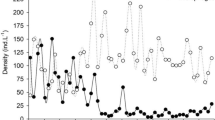Abstract
Daily plankton collections were taken from a billabong of the River Murray for two weeks prior to inundation in March 1990, and continued for ten days after flooding. Quantitative responses of the plankton community and the component species were analysed against measured environmental variables and between species. Rotifers and copepod nauplii were the predominant net plankton (> 53 µm). Significant negative or positive responses to inundation were detected for most common taxa of 63 rotifer species recorded. A four-fold dilution from intrusion of river water masked rapid population increases. Opportunistic responses to inundation appear to be a survival strategy in the highly unpredictable billabong environment.
Similar content being viewed by others
References
Boon, P. I. & R. J. Shiel, 1990. Grazing on bacteria by zooplankton in Australian billabongs. Aust. J. Mar. Freshwat. Res. 41: 247–257.
Boon, P. I., J. Frankenberg, T. J. Hillman, R. L. Oliver & R. J. Shiel, 1990. Billabongs. In N. Mackay & D. Eastburn (eds), The Murray. Murray-Darling Basin Commission, Canberra: 183–200.
Hellawell, J. M., 1978. Biological Surveillance of Rivers. Water Research Centre, Stevenage.
Hillman, T. J., 1986. Billabongs. In P. De Deckker & W. D. Williams (eds), Limnology in Australia. CSIRO, Melb./ Dr W. Junk Publishers, Dordrecht: 457–470.
Hillman, T. J. & R. J. Shiel, 1991. Macro- and microinvertebrates in Australian billabongs. Verh. int. Ver. Limnol. 24: 1581–1587.
Horn, H. S. & R. H. Macarthur, 1972. Competition among fugitive species in a harlequin environment. Ecology 53: 749–752.
Koste, W., 1978. Rotatoria. Die Rädertiere Mitteleuropas. Borntraeger, Stuttgart.
Koste, W., 1981. Zur Morphologie, Systematik und Ökologie von neuen monogononten Rädertieren (Rotatoria) aus dem überschwemmungsgebiet des Magela Ck in der Alligator River Region, Australiens. N.T. Teil 1. Osnabrücker naturwiss. Mitt. 8: 97–126.
Koste, W. & R. J. Shiel, 1990. Rotifera from Australian inland waters VI. Proalidae & Lindiidae (Rotifera: Monogononta). Trans R. Soc. S. Aust. 114: 129–143.
Kutikova, L. A., 1970. Kolovratki fauni CCCP. Acad. Sci., Leningrad.
Mackay, N. & D. Eastburn (eds), 1990. The Murray. Murray-Darling Basin Commission, Canberra: 1–363.
Manuel, J. De & R. J. Shiel, in press. Biodiversity in billabongs: the rotifers of floating Azolla and Ricciocarpus mats. Arch. Hydrobiol.
May, L., 1986. Rotifer sampling — a complete species list from one visit? Hydrobiologia 134: 117–120.
Shiel, R. J. 1990. Zooplankton. In N. Mackay & D. Eastburn (eds), The Murray. Murray-Darling Basin Commission, Canberra: 275–286.
Shiel, R. J. & W. D. Williams, 1990. Species richness in tropical freshwaters of Australia. Hydrobiologia 202: 175–183.
Southcott, R. V. & R. T. Lange, 1971. Acarine and other microfossils from the Maslin Eocene, South Australia. Rec. S. Aust. Mus. 16: 17–19.
Author information
Authors and Affiliations
Rights and permissions
About this article
Cite this article
Tan, LW., Shiel, R.J. Responses of billabong rotifer communities to inundation. Hydrobiologia 255, 361–369 (1993). https://doi.org/10.1007/BF00025861
Issue Date:
DOI: https://doi.org/10.1007/BF00025861



